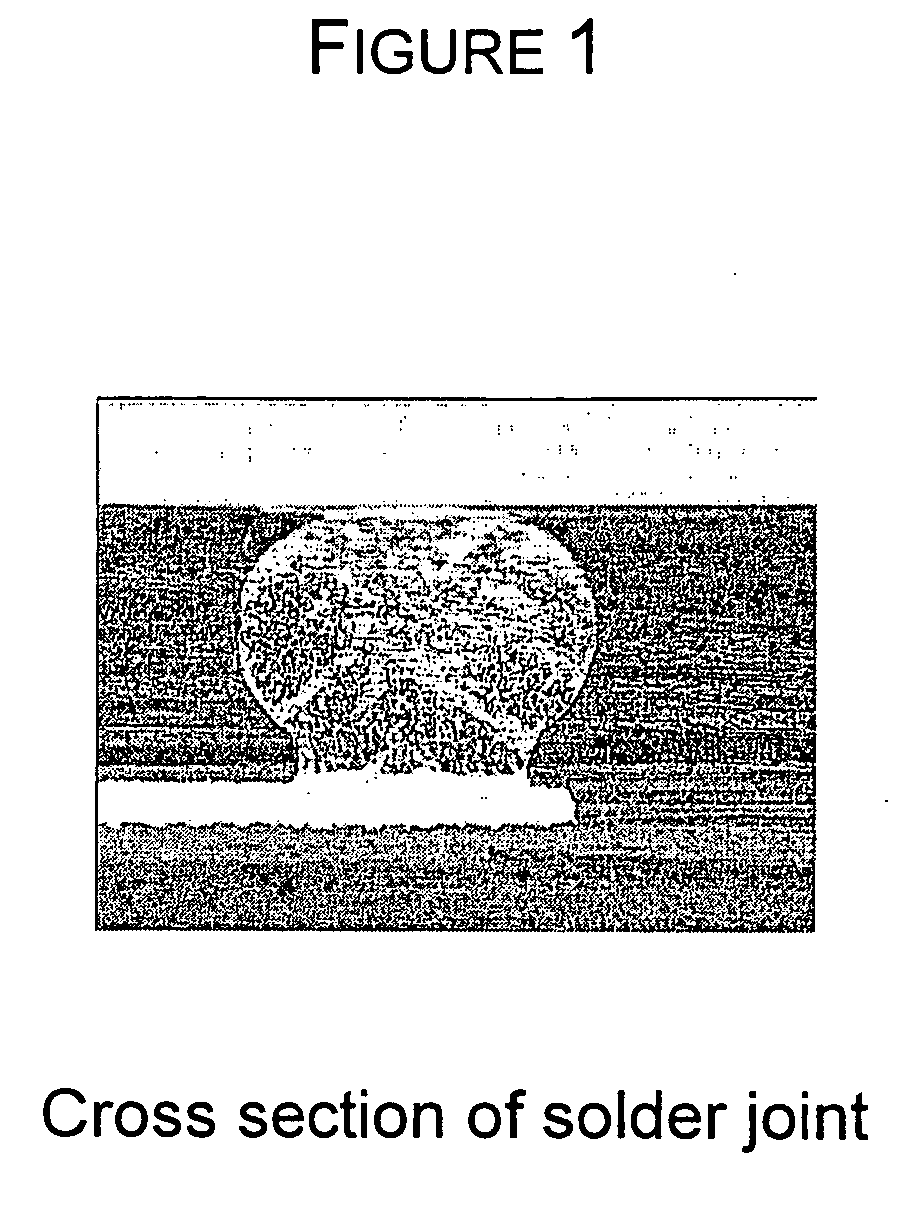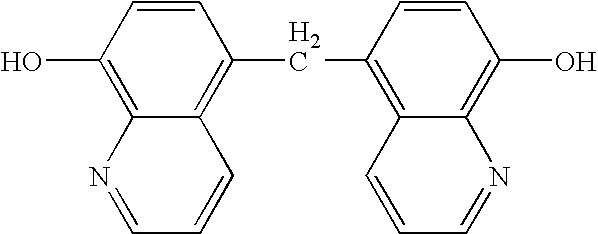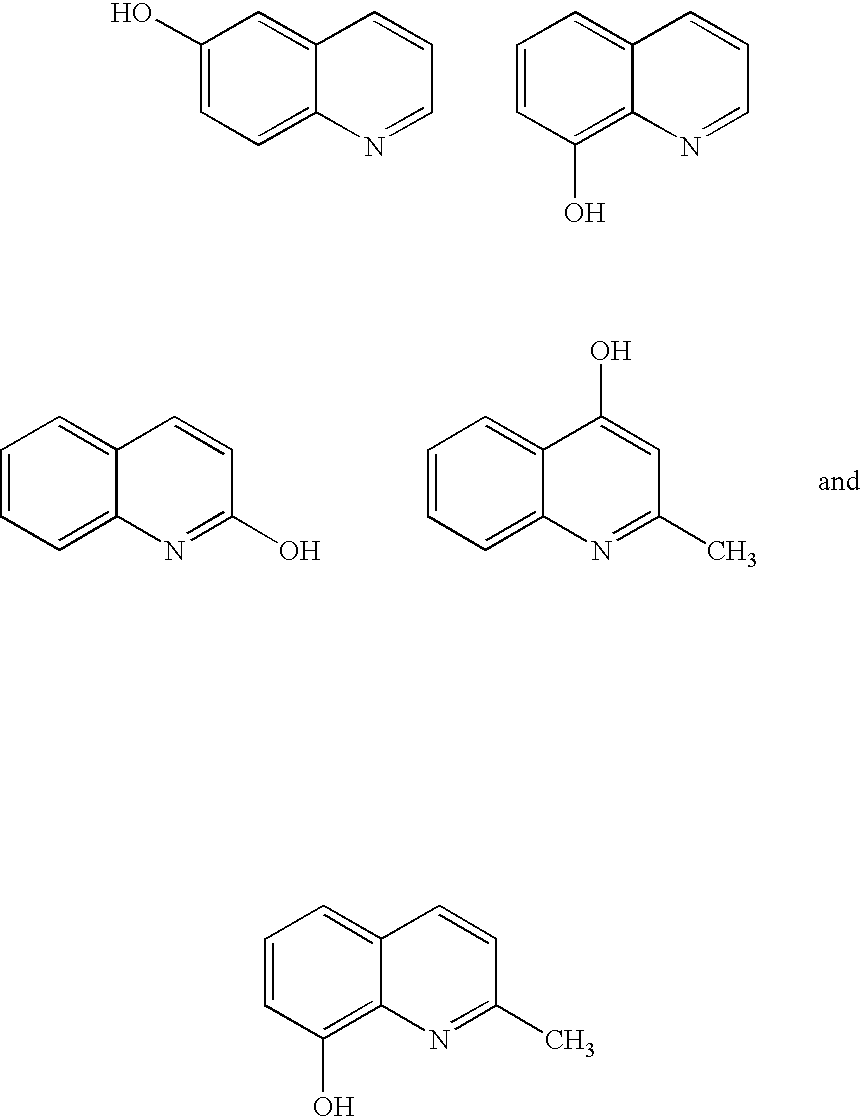Quinolinols as fluxing and accelerating agents for underfill compositions
a technology of quinolinols and compositions, applied in the field of compositions, can solve the problems of failure of semiconductor packages, fluxing agents in no-flow underfill materials are typically organic acids or anhydrides, and are not suitable for chemistries, so as to accelerate composition cure, increase composition tg, and increase the effect of glass transition temperatur
- Summary
- Abstract
- Description
- Claims
- Application Information
AI Technical Summary
Benefits of technology
Problems solved by technology
Method used
Image
Examples
example 1
Preparation of Bis-Quinolinol
[0048]
According to the procedure described by Donald. S. Noyce and Lloyd J. Dolby, Amino- and Chloromethylation of 8-Quinolinol. Mechanism of Preponderant ortho Substitution in Phenols under Mannich Conditions, in The Journal of Organic Chemistry, Volume 26, number 10, Oct. 24, 1961, at pages 4078 to 4083, fluxing agent bis-quinolinol was prepared via the reaction of 8-quinolinol and an excess of formaldehyde in an aqueous hydrochloric acid solution. 8-Quinolinol (29.0 grams, 0.2000 mol) and hydrochloric acid (37%, 85 mL) were combined in a four-neck, 250 mL, round bottom flask equipped with a magnetic stir bar, reflux condenser and hot oil bath. Initially, an exotherm of ˜25° C. was observed upon mixing these reagents. Formaldehyde (37%, 9 mL), was then added which resulted in a change from a clear yellow solution to a gold solution. The mixture was heated at reflux for 90 minutes. During this time heavy acidic fumes were generated. After mixing for 1...
example 2
Preparation of Quinolinol / Piperidine
[0052]
Quinolinol can be volatile, and in this example, a quinolinol / piperidine derivative was prepared in order to increase the bulk and reduce the volatility of quinolinol. The asymmetry of this derivative promoted a lower melting point than that found for the bis-quinolinol. Quinolinol / piperidine was prepared in a melt by the reaction of equimolar amounts of 8-quinolinol, piperidine and paraformaldehyde.
[0053] 8-Quinolinol (29.0 grams, 0.2000 mol), piperidine (17.0 grams, 0.2000 mol) and paraformaldehyde (6.0 grams, 0.2000 mol) were charged to a 100 mL 3-neck round bottom flask equipped with a mechanical mixer, thermometer and reflux condenser. With mixing, the solids partially dissolved to an opaque gold liquid and the reaction temperature rose from room temperature to 71° C. within five minutes. Mixing was continued until the reaction temperature dropped to −60° C. At this point, the flask was placed in a hot oil bath preheated to 100° C. T...
example 3
Preparation of Hydroxy-Functionalized Quinolinol
[0055]
An hydroxy functionalized quinolinol intermediate was prepared via the reaction of equimolar amounts of 8-quinolinol and formaldehyde in an aqueous hydrochloric acid solution. (Note that quinolinol was synthesized similarly but with a molar excess of formaldehyde relative to 8-quinolinol). The product of this reaction showed improved solubility over bis-quinolinol and was more easily characterized. The synthesis procedure was obtained from Donald. S. Noyce and Lloyd J. Dolby, Amino- and Chloromethylation of 8-Quinolinol. Mechanism of Preponderant ortho Substitution in Phenols under Mannich Conditions, in The Journal of Organic Chemistry, Volume 26, number 10, Oct. 24, 1961, at pages 4078 to 4083.
[0056] 8-Quinolinol (120.0 grams, 0.8267 mol), hydrochloric acid (37%, 352 mL) and formaldehyde (37%, 67.7 grams), were combined in a four-neck one liter round bottom flask equipped with a magnetic stir bar, thermometer, reflux condens...
PUM
| Property | Measurement | Unit |
|---|---|---|
| Tg | aaaaa | aaaaa |
| Tg | aaaaa | aaaaa |
| temperature | aaaaa | aaaaa |
Abstract
Description
Claims
Application Information
 Login to View More
Login to View More - R&D
- Intellectual Property
- Life Sciences
- Materials
- Tech Scout
- Unparalleled Data Quality
- Higher Quality Content
- 60% Fewer Hallucinations
Browse by: Latest US Patents, China's latest patents, Technical Efficacy Thesaurus, Application Domain, Technology Topic, Popular Technical Reports.
© 2025 PatSnap. All rights reserved.Legal|Privacy policy|Modern Slavery Act Transparency Statement|Sitemap|About US| Contact US: help@patsnap.com



